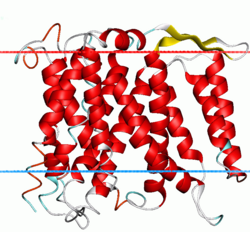Biology:Sodium–hydrogen antiporter
The sodium–hydrogen antiporter or sodium–proton exchanger (Na+/H+ exchanger) is a membrane protein that transports Na+ into the cell, and H+ out of the cell (antiport).
| Na+/H+ antiporter 1 | |||||||||
|---|---|---|---|---|---|---|---|---|---|
 | |||||||||
| Identifiers | |||||||||
| Symbol | Na_H_antiport_1 | ||||||||
| Pfam | PF06965 | ||||||||
| InterPro | IPR004670 | ||||||||
| TCDB | 2.A.36 | ||||||||
| OPM superfamily | 106 | ||||||||
| OPM protein | 1zcd | ||||||||
| |||||||||
Function
They are found in the membranes of many cells, and especially in those of the nephron of the kidney, specifically in the intercalary cells of the collecting duct and in the epithelial cells of the proximal convoluted tubule. The membrane pump is primarily responsible for maintaining homeostasis of pH and sodium.[1] Defects in Na+/H+ antiporters may result in heart or kidney failure.[2] Angiotensin II upregulates this antiporter in the proximal convoluted tubule in order to promote Na+ reabsorption and H+ secretion. Na+/H+ exchangers are thought to be implicated in other disorders such as hypertension. In one study, transgenic mice over expressing this membrane protein were shown to have increased reabsorption and retention of sodium after increased salt intake.[3]
In dopamine receptor signalling,[4] the widely expressed Na+/H+ exchanger NHE-1 is activated downstream of the D2,[5] D3,[6][7] and D4 receptors.[8]
Isoforms
There are several isoforms of the antiporter:
- Sodium–hydrogen antiporter 1
- Sodium–hydrogen antiporter 2
- Sodium–hydrogen antiporter 3
- Sodium–hydrogen antiporter 4
- Sodium–hydrogen antiporter 5
- Sodium–hydrogen antiporter 6
- Sodium–hydrogen antiporter 7
- Sodium–hydrogen antiporter 8
- Sodium–hydrogen antiporter 9
Families
There are several families of sodium/proton antiporters that facilitate the exchange of sodium ions with protons across the lipid membrane. Some of them include:[9]
- TC# 2.A.33 - Na+:H+ Antiporter (NhaA) Family
- TC# 2.A.34 - Na+:H+ Antiporter (NhaB) Family
- TC# 2.A.35 - Na+:H+ Antiporter (NhaC) Family
- TC# 2.A.36 - Monovalent Cation:Proton Antiporter-1 (CPA1) Family
- TC# 2.A.37 - Monovalent Cation:Proton Antiporter-2 (CPA2) Family
- TC# 2.A.62 - Na+:H+ Antiporter (NhaD) Family
- TC# 2.A.63 - Monovalent Cation (K+ or Na+):Proton Antiporter-3 (CPA3) Family
- TC# 2.A.111 - Na+:H+ Antiporter (NhaE) Family
References
- ↑ Padan, Etana; Landau, Meytal (2016). "Chapter 12: Sodium-Proton (Na+/H+) Antiporters:Properties and Roles in Health and Disease". in Sigel, Astrid; Sigel, Helmut; Sigel, Roland K.O.. The Alkali Metal Ions: Their Role in Life. Metal Ions in Life Sciences. 16. Springer. pp. 391–458. doi:10.1007/978-3-319-21756-7_12. ISBN 978-3-319-21755-0.
- ↑ "Na+/H+ exchangers in renal regulation of acid-base balance". Seminars in Nephrology 26 (5): 334–44. September 2006. doi:10.1016/j.semnephrol.2006.07.001. PMID 17071327.
- ↑ Kuro-o, M (January 1995). "Salt-sensitive hypertension in transgenic mice overexpressing Na(+)-proton exchanger.". Circulation Research 76 (1): 148–153. doi:10.1161/01.res.76.1.148. PMID 8001273.
- ↑ "Mammalian Na+/H+ exchanger gene family: structure and function studies". The American Journal of Physiology 269 (1 Pt 1): G1–11. July 1995. doi:10.1152/ajpgi.1995.269.1.G1. PMID 7631785.
- ↑ "Dopamine D2 receptor stimulation of Na+/H+ exchange assessed by quantification of extracellular acidification". The Journal of Biological Chemistry 267 (36): 25748–53. December 1992. PMID 1361188.
- ↑ "Regulation and functional characterization of a rat recombinant dopamine D3 receptor". Synapse 21 (1): 1–9. September 1995. doi:10.1002/syn.890210102. PMID 8525456.
- ↑ "Activation of heterologously expressed D3 dopamine receptors: comparison with D2 dopamine receptors". Molecular Pharmacology 45 (1): 51–60. January 1994. PMID 8302280.
- ↑ "D4 dopamine receptor-mediated signaling events determined in transfected Chinese hamster ovary cells". The Journal of Biological Chemistry 269 (16): 11813–9. April 1994. PMID 7512953.
- ↑ "TCDB » HOME". http://www.tcdb.org/.
External links
- Sodium-Hydrogen+Exchanger at the US National Library of Medicine Medical Subject Headings (MeSH)
 |

